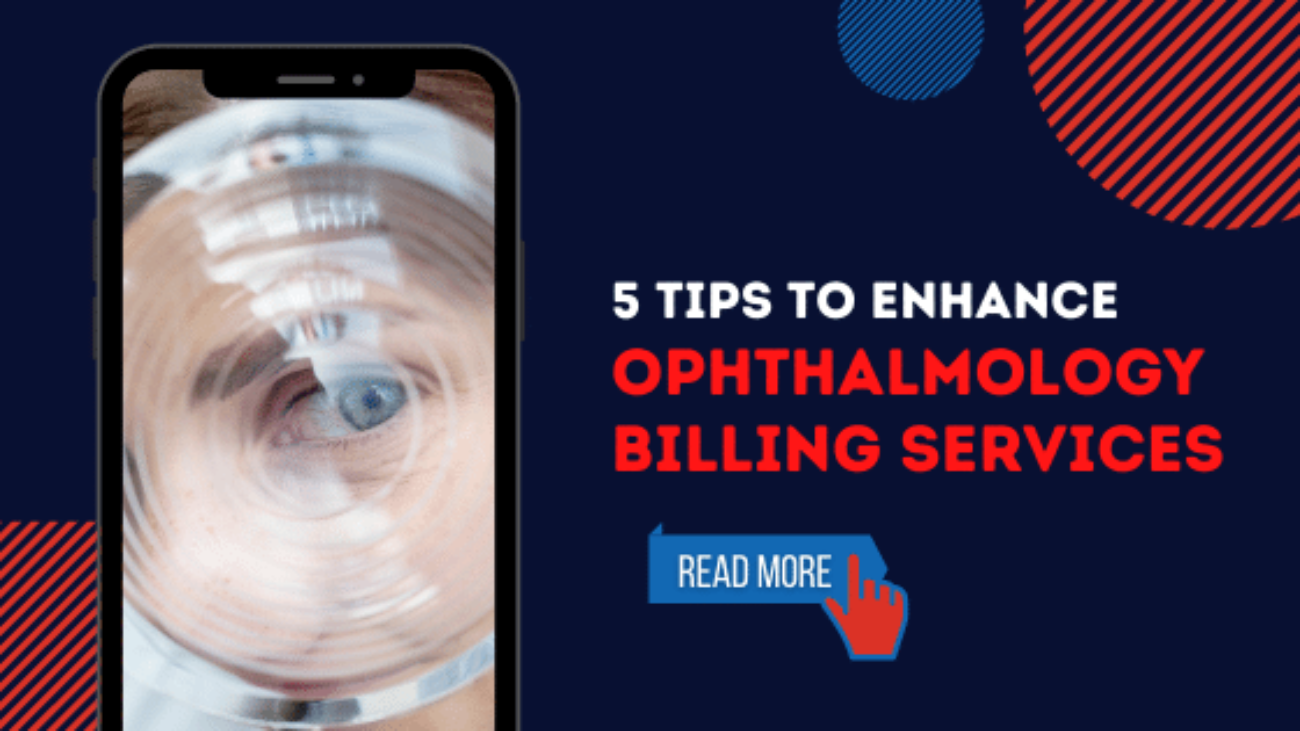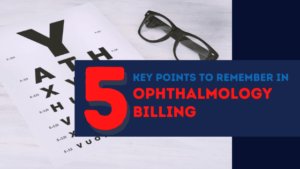Alright! When you discuss about Ophthalmology billing services, it creates confusion with the way of billing and the coding differences while billing the claims. But, healthcare professionals want to find a solution to have a feasible billing practice, keeping all these confusions away. Though the insurance for Ophthalmology billing does not go with medical insurance, most of the patients do not realize the consequences.
Anyone involved in Ophthalmology billing process knows well that it’s not so easy! Opportunities might go wrong, revenue reimbursements might get slower and sometimes loss of payments also occur. So, to prevent such situations and enhance revenue payments or reimbursements, take a look on the below tips. Try following them!
Those tips include:
- Choose accurately between E/M codes and Eye codes
- Keep an eye on out of network billing
- Revise patients billing statements
- Know the difference
- Diagnostic testing bills must be accurate
1. Choose accurately between E/M codes and Eye codes:
- As known, ophthalmology billing is different from other specialties. It contains two sets of codes which causes major confusion.
- To code accurately and avoid the confusion, it’s better have a check on the insurance company’s rules and regulations, exam elements performed, reimbursement rates and medical necessity requirements.
- For clarity, also consider additional factors that draw your attention towards considering right codes for the services provided.
- On a first priority basis, check thoroughly the diagnosis codes as Eye codes are more restrictive to meet medical necessities and can vary between insurance companies.
- E/M codes are different as they don’t follow any restrictions to meet medical necessities.
- E/M codes are typically used for visits with medical elements. In case the exam is complete visual and has no medical elements involved, then Eye code is the right choice.
- Check patient history. This is one of the major and essential tasks to be performed before billing a procedure due to frequent edits in Eye codes. Specific codes like 92014 are limited for billing once in 12 months. Well, it doesn’t imply E/M codes.
- Insurance guidelines are prominent and verification is a must do tasks. Even though document requirements for E/M codes are standardized for all the insurance companies, required documents for Eye codes definitely vary.
- If the healthcare professionals are in the need to meet the required documentary for both E/M codes and Eye codes, then they will have to choose the exact and accurate codes to experience high reimbursement rates.
2. Keep an eye on out of network billing:
- Many healthcare providers choose to bill out of network which causes a greater risk that includes denials and rejections, delayed payments also fraudulent activities. If at all healthcare professionals choose to bill out of network, here are few tips to follow.
- Be completely clear and open about the out of network billing with the patients. Explain about out of network billing verbally as well as mention in the financial policies of the practice.
- Work hard and give the fullest to prevent imbalanced billing and to expect payments earlier.
- Do not waive patient co-pays regularly which also include out of pocket payments. It’s considered to be in violation of Anti-Kickback statute.
- Use accurate charges and amount of claims while billing the procedures.
3. Revise Patient Billing Payments:
- Medical billing statements are often confusing for even patients with good health and financial literacy.
- It’s important to be clear and crisp on the statements of patients, or else can be a big deal and be pushed for later consideration.
- It also leaves more A/R days creating confusion and less patient satisfaction.
- To avoid these, explain the services in simple words rather making it complicated. Don’t use codes or medical terms because patients may not be aware of these and wanted to know for exactly the payments are for!
- Always choose clean layouts with bigger fonts leaving more white space. Delete unwanted redundancy.
- Instead, give a description for the procedures they owe and for they don’t. Remind them with clear a explanation if there’s any due from the patient end.
4. Know the difference:
- Medicare and commercial insurance companies vary in coverage determinations and ophthalmology billing guidelines.
- Medicare has its own rules which differ and procedures that stand away for choosing codes including required documentation they need to refer.
- It’s very important and crucial to understand insurance companies’ guidelines and policies to submit clean claims.
- For instance, Medicare expects healthcare professionals to bill with bilateral claims explaining the procedure code on the claim with modifier50.
- Commercial insurance companies would want to list the procedure code with one line modifier LT. The other line modifier with RT.
5. Diagnostic testing bills must be accurate:
- Diagnostic testing for ophthalmology billing is always under inspection and any violation can land healthcare professionals under bigger problems.
- Healthcare professionals must pay attention towards accurate modifiers for accurate codes meeting the guidelines.
- Visual field testing is the general part of ophthalmology services. Never try to report visual field testing with 92081-92083 as they are considered as up coding.
- Ophthalmology clinical testing need not be reported bilaterally . Do it once on a claim even if it’s performed on one or both eyes.
- Check if the documentation supports medical necessities.
- Learn to use technical components for modifiers so that healthcare professionals can bill the A-scan component only once though it’s for both eyes. Hence it’s considered as bilateral.
- Professional components are unilateral. Separate calculations on each eye can be performed prior to surgery.
Hope you got the information on ophthalmology billing. For more suggestions, please comment below, we will definitely consider them if relevant. For more queries and updates on healthcare, please subscribe to our blog.




